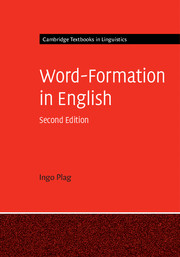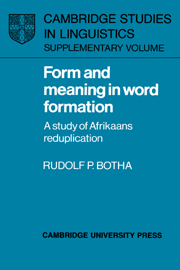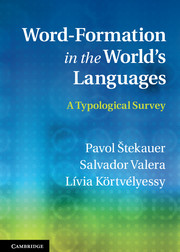Word-Formation in English
2nd Edition
Part of Cambridge Textbooks in Linguistics
- Author: Ingo Plag, Heinrich-Heine-Universität Düsseldorf
- Date Published: July 2018
- availability: Available
- format: Paperback
- isbn: 9781316623299
Paperback
-
This book is the second edition of a highly successful introduction to the study of word-formation, that is, the ways in which new words are built on the bases of other words (e.g. happy - happy-ness), focusing on English. The book's didactic aim is to enable students with little or no prior linguistic knowledge to do their own practical analyses of complex words. Readers are familiarized with the necessary methodological tools to obtain and analyze relevant data and are shown how to relate their findings to theoretical problems and debates. The second edition incorporates new developments in morphology at both the methodological and the theoretical level. It introduces the use of new corpora and data bases, acquaints the reader with state-of-the-art computational algorithms modeling morphology, and brings in current debates and theories.
Read more- Fully updated to account for important new empirical findings and theoretical developments in the field over the past fifteen years
- Chapters 3 and 4 have been revised to include new information on methodological tools and their implementation
- New references are provided to online sources such as the Oxford English Dictionary and the Corpus of Contemporary American English, as well as a range of other new databases and websites
Customer reviews
17th Oct 2024 by UName-801592
Good books and interesting for me because im learning about morpheme and i got everything in this book
Review was not posted due to profanity
×Product details
- Edition: 2nd Edition
- Date Published: July 2018
- format: Paperback
- isbn: 9781316623299
- length: 258 pages
- dimensions: 245 x 174 x 13 mm
- weight: 0.53kg
- contains: 39 b/w illus. 36 tables
- availability: Available
Table of Contents
Preface to the first edition
Preface to the second edition
Abbreviations and notational conventions
Introduction: what this book is about and how it can be used
1. Basic concepts
1.1. What is a word?
1.2. Studying word-formation
1.3. Inflection and derivation
1.4. Summary
Further reading
Exercises
2. Studying complex words
2.1. Identifying morphemes
2.1.1. The morpheme as the minimal linguistic sign
2.1.2. Problems with the morpheme: the mapping of form and meaning
2.2. Allomorphy
2.3. Establishing word-formation rules
2.4. Multiple affixation and compounding
2.5. Summary
Further reading
Exercises
3. Productivity and the mental lexicon
3.1. Introduction: what is productivity?
3.2. Possible and actual words
3.3. Complex words in the lexicon
3.4. Measuring productivity
3.5. Constraining productivity
3.5.1. Pragmatic restrictions
3.5.2. Structural restrictions
3.5.3. Blocking
3.6. Summary
Further reading
Exercises
4. Affixation
4.1. What is an affix?
4.2. How to investigate affixes: more on methodology
4.3. General properties of English affixation
4.3.1. Phonological properties
4.3.2. Morphological properties
4.3.3. Semantic properties
4.3.4. Classifying affixes
4.4. Suffixes
4.4.1. Nominal suffixes
4.4.2. Verbal suffixes
4.4.3. Adjectival suffixes
4.4.4. Adverbial suffixes
4.5. Prefixes
4.6. Infixation
4.7. Summary
Further reading
Exercises
5. Derivation without affixation
5.1. Conversion
5.1.1. The directionality of conversion
5.1.2. Conversion or zero-affixation?
5.1.3. Conversion: syntactic or morphological?
5.2. Prosodic morphology
5.2.1. Truncations: truncated names, -y diminutives, and clippings
5.2.2. Blends
5.3. Abbreviations and acronyms
5.4. Summary
Further reading
Exercises
6. Compounding
6.1. Recognising compounds
6.1.1. What are compounds made of?
6.1.2. More on the structure of compounds: the notion of head
6.1.3. Canonical and non-canonical compounds
6.1.4. Summary
6.2. An inventory of compounding patterns
6.3. Nominal compounds
6.3.1. Headedness
6.3.2. Interpreting nominal compounds
6.3.3. Stress assignment
6.4. Adjectival compounds
6.5. Verbal compounds
6.6
Neoclassical compounds
6.7. Compounding: syntax or morphology?
6.8. Summary
Further reading
Exercises
7. Theoretical issues: modelling word-formation
7.1. Introduction: why theory?
7.2. Phonology-morphology interaction
7.3. Affix ordering
7.4. The nature of word-formation rules
7.4.1. Morpheme-based morphology
7.4.2. Word-based morphology
7.4.3. Analogy
7.4.4. Naive Discriminative Learning
7.4.5. Summary
Further reading
Exercises
Answer key to exercises
Chapter 1
Chapter 2
Chapter 3
Chapter 4
Chapter 5
Chapter 6
Chapter 7
References
Index.
Sorry, this resource is locked
Please register or sign in to request access. If you are having problems accessing these resources please email [email protected]
Register Sign in» Proceed
You are now leaving the Cambridge University Press website. Your eBook purchase and download will be completed by our partner www.ebooks.com. Please see the permission section of the www.ebooks.com catalogue page for details of the print & copy limits on our eBooks.
Continue ×Are you sure you want to delete your account?
This cannot be undone.
Thank you for your feedback which will help us improve our service.
If you requested a response, we will make sure to get back to you shortly.
×




